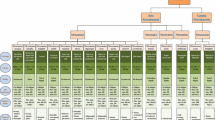Abstract
Chemolithoautotrophically growing cells of Nitrosomonas europaea quantitatively oxidized ammonia to nitrite under aerobic conditions with no loss of inorganic nitrogen. Significant inorganic nitrogen losses occurred when cells were growing mixotrophically with ammonium, pyruvate, yeast extract and peptone. Under oxygen limitation the nitrogen losses were even higher. In the absence of oxygen pyruvate was metabolized slowly while nitrite was consumed concomitantly. Nitrogen losses were due to the production of nitric oxide and nitrous oxide. In mixed cultures of Nitrosomonas and Nitrobacter, strong inhibition of nitrite oxidation was reproducibly measured. NO and ammonium were not inhibitory to Nitrobacter. First evidence is given that hydroxylamine, the intermediate of the Nitrosomonas monooxygenase-reaction, is formed. 0.2 to 1.7 μM NH2OH were produced by mixotrophically growing cells of Nitrosomonas and Nitrosovibrio. Hydroxylamine was both a selective inhibitory agent to Nitrobacter cells and a strong reductant which reduced nitrite to NO and N2O. It is discussed whether chemodenitrification or denitrification is the most abundant process for NO and N2O production of Nitrosomonas.
Similar content being viewed by others
References
Anderson JH (1964) The copper-catalysed oxidation of hydroxylamine. Analyst 89: 357–362
Baumgärtner M, Sameluck F, Bock E, Conrad R (1991) Production of nitric oxide by ammonium-oxidizing bacteria colonizing building stones. FEMS Microbiol Ecol 85: 95–100
Bradford MM (1976) Rapid and sensitive method for the quantitation of microgram quantities of protein, utilizing the principle of protein-dye binding. Anal Biochem 72: 248–254
vonBreymann MT, deAngelis MA, Gordon LI (1982) Gas chromatography with electron capture detection for determination of hydroxylamine in seawater. Anal Chem 54: 1209–1210
Castell CH, Mapplebeck EG (1956) A note on the production of nitrite from hydroxylamine by some heterotrophic bacteria. J Fish Res Bd Can 13: 201–206
Castignetti D, Gunner HB (1982) Differential tolerance of hydroxylamine by an Alcaligenes sp., a heterotrophic nitrifier, and by Nitrobacter agilis. Can J Microbiol 28: 148–150
Corbin JL (1984) Liquid chromatographic-fluorescence determination of ammonia from nitrogenase reactions: a 2 min assay. Appl Environ Microbiol 47: 1027–1030
Freitag A, Rudert M, Bock E (1987) Growth of Nitrobacter by dissimilatoric nitrate reduction. FEMS Microbiol Lett 48: 105–109
Garret RH, Nason A (1969) Further purification and properties of Neurospora nitrate reductase. J Biol Chem 244: 2870–2882
German standard methods for the examination of water, waste water and sludge (1975); cations (group E); determination of ammonia-nitrogen (E5). Fachgruppe Wasserchemie in der Gesellschaft Deutscher Chemiker (eds) Verlag Chemie, Weinheim
Hooper AB (1968) A nitrite-reducing enzyme from Nitrosomonas europaea. Preliminary characterisation with hydroxylamine as electron donor. Biochim Biophys Acta 162: 49–65
Hooper AB (1969) Lag phase of ammonia oxidation resting cells of Nitrosomonas europaea. J Bacteriol 97: 968–969
Hooper AB, Terry KR (1974) Photoinactivation of ammonia oxidation in Nitrosomonas. J Bacteriol 119: 899–906
Hooper AB, Terry KR (1979) Hydroxylamine oxidoreductase of Nitrosomonas: production of nitric oxide from hydroxylamine. Biochim Biophys Acta 571: 12–20
Luria SE (1960) Data for a bacterium, Escherichia coli. In: Gunsalus IC, Stanier RY (eds) The bacteria, vol 1, chapter 1. Academic Press, New York
Miller DJ, Wood PM (1983) The soluble cytochrome oxidase of Nitrosomonas europaea. J Gen Microbiol 129: 1645–1650
Poth M, Focht DD (1985) 15N kinetic analysis of N2O production by Nitrosomonas europaea: an examination of nitrifier denitrification. Appl Environ Microbiol 49: 1134–1141
Rajendran A, Venugopalan VK (1976) Hydroxylamine formation in laboratory experiments on marine nitrification. Marine Chem 4: 93–98
Ritchie GAF, Nicholas DJD (1972) Identification of the sources of nitrous oxide produced by oxidation and reductive processes in Nitrosomonas europaea. Biochem J 126: 1181–1191
Suzuki I, Kwok SC (1969) Oxidation of ammonia by spheroplasts of Nitrosomonas europaea. J Bacteriol 99: 897–898
Velghe N, Claeys A (1985) Rapid spectrometric determination of nitrate in mineral waters with resorcinol. Analyst 110: 313–314
Wickins JF (1983) Studies on marine biological filters. Water Res 17: 1769–1780
Author information
Authors and Affiliations
Rights and permissions
About this article
Cite this article
Stüven, R., Vollmer, M. & Bock, E. The impact of organic matter on nitric oxide formation by Nitrosomonas europaea . Arch. Microbiol. 158, 439–443 (1992). https://doi.org/10.1007/BF00276306
Received:
Accepted:
Issue Date:
DOI: https://doi.org/10.1007/BF00276306




